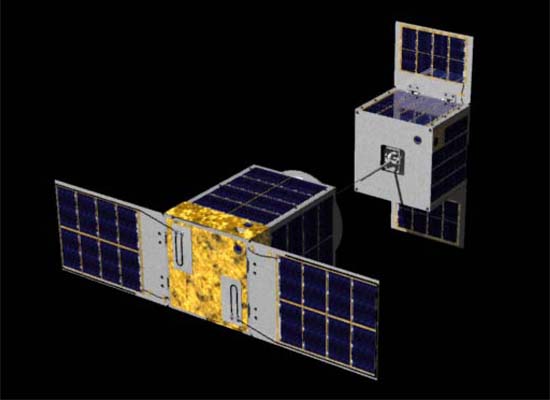[[Series 3: Introduction of the Current Status of Small Japanese Satellites]] Introduction of STARS
An ultra small satellite, will be the first satellite from Kagawa, Shikoku, Japan
Report from Mr. Masahiro Nohmi, Associate Professor at the faculty of engineering of Kagawa University
The Kagawa Satellite Project started in January 2005, led mainly by the staff of the Nohmi Laboratory in the department of engineering at Kagawa University.
In May 2007, STARS was selected as one of the candidates of small satellites to be launched by JAXA's H-IIA rocket together with the main satellite GOSAT, which is scheduled to be launched in 2008.
With the finalization of GOSAT's launch, the development of STARS was materialized all at once and has been promoted at high speed.
The Kagawa satellite, STARS, aims to implement space experiments to technologically verify a tethered space robot and to promote the popularization, education and comprehension regarding space technology in the local region, throughout the development of a practical system for space.
STARS aims to verify the technology and has the following three characteristics.
i. It is a family satellite (the mother and daughter satellite are launched at the same time).
ii. It has a tether system which can be used for a rendezvous between the mother and daughter satellite, and it can become a bigger space system than the one loaded in the rocket at launch.
iii. It is a robot satellite which can actively move in space.
This satellite aims to verify the space technology regarding a tethered space robot, which is the subject of the most advanced research in the world and is being conducted at the Nohmi Laboratory in the department of engineering at Kagawa University.
A tether is something like a string that connects two objects, and tethered space robots are robots that are tied together with a tether in space.
Tethers bend, twist and become unstable when there is no gravity. It is also difficult to control robots that are tied together with an unstable tether.
However, if we can overcome these difficulties there are several merits to having a tether, such as it is easy to rescue a robot in the event of equipment failure and the robot can be operated without any fuel. And that means we can develop smaller robots.
Smallness is very important in space and offers several excellent advantages such as lower fuel consumption, an ability to dexterously maneuver around a large flexible structure, and the fact that little damage is caused in the event of a collision.
We have positioned this project as one to promote, popularize and educate people about space technology in the local region, and have been developing it jointly with local medium- and small-sized enterprises. We have entrusted individual enterprises with the design, development and manufacture of subsystems such as the power system, electric control system and camera system, as well as the paddle deployment system. And we have developed the structural system and asked five enterprises to manufacture it. We have been developing and manufacturing the satellite antenna and ground station in cooperation with amateur operators.
And also we have been implementing vibration tests and antenna performance tests in cooperation with the Kagawa Prefectural Industrial Technology Center.
At present we are manufacturing a prototype flight model which will be completed by the end of April 2008.
As activities to promote the understanding of science using local space technology, we have been giving lectures related to space technology that were planned by students, at study meetings in which people from enterprises assemble, and at committees in which there is collaboration between industry, government and academia.
And also we have been providing people with opportunities to see and touch science and technology by holding radio experiments and classes for paper craft for elementary and lower secondary school pupils; by conducting an open experiment on the ground test of CanSat (controlling the device and doing a communication test while the satellite falls to the ground on a parachute after being ejected from a balloon); and exhibiting satellite devices in the local ICT future festival in Kagawa, in the Sanuki Festival 2005 and on the open campus of Kagawa University.
Our project has being reported by the mass media many times and has aroused the interest of local people. We have therefore made a website for the project and established a Kagawa satellite club, in which local people can participate.

Conceptual rendering of the finished satellite (the colors except for the cell's color are yet to be determined)
Kagawa University, the faculty of Engineering Website: http://www.kagawa-u.ac.jp/kagawa-u_eng/itwinfo/cl1000070/